As with other compositional classes of artifactual materials, no universally accepted methodological protocols exist for the analysis of plant fiber artifacts. However, there are widely accepted guidelines for the analysis of most types of fiber artifacts. The suggested procedures outlined below derive from a series of what have become for most fiber analysts ‘the standard references’, though it should be stressed that other analytical strategies have been and are still in use.
As defined here, the analysis of any kind of fiber artifact is essentially a progressive and reductive taxonomic or classificatory exercise, the ultimate results of which are analytical types or, in some cases, idiosyncratic categories. In this context, a type consists of a constellation of manufacturing attributes or features the collective total of which is the specimen under scrutiny. Because, as noted in the Introduction, many of these construction attributes are culturally standardized, the resultant ‘types’ are perforce considerably more than simply the convenient creation of the analyst.
Basketry and Textiles
Basketry is a class of fiber artifact which includes several distinct kinds of items, including rigid and semirigid containers or baskets proper, matting, and bags. Matting is essentially ‘two-dimensional’ or flat, whereas bags are ‘three-dimensional’. Bags can be viewed as intermediate forms because they are two-dimensional when empty but three-dimensional when filled. As Driver (1961) points out, these artifacts can be treated as a unit because the overall technique of manufacture is the same in all instances. All forms of basketry are manually woven without frame or loom. As all basketry is woven, it is technically a variety of textile.
For most analysts, the term ‘textiles’ is reserved for fiber artifacts which are infinitely flexible cloth fabrics produced with a frame or loom. While there is obviously some overlap between basketry and textiles (e. g., twined cloth), the presence or absence of a frame or loom is a reasonably consistent classificatory diagnostic.
The analytical protocols presented here for basketry and textiles follow Adovasio and Emery, respectively. According to Adovasio, the classification of basketry may be likened to the taxonomy of living or extinct plants and animals. The operation consists of two basic steps. The basketry assemblage from any given site is first divided into major groups or subclasses of weaves; then each subclass is divided into technological types. The entire procedure reduces the assemblage to progressively smaller units of increasingly greater taxonomic resolution or precision.
It is generally agreed that basketry may be divided into three subclasses of weaves that are mutually exclusive and taxonomically distinct: twining, coiling, and plaiting. The potential number of technological types within each subclass is relatively great.
Twining is a subclass of basket weaves made by sewing stationary (passive) vertical elements, or warps, with moving (active) horizontal elements called wefts. Twining is used to produce containers, mats, and bags, as well as fish traps, hats, clothing, and other less typical basketry forms (Figure 1).
Coiling is a subclass of basket weaves made by sewing stationary horizontal elements (the foundation) with moving vertical elements (stitches). Coiling techniques are used almost exclusively in making containers and hats but are very rarely used for bags. Mats and other forms are seldom, if ever, produced by coiling (Figure 2).
Plaiting is a subclass of basket weaves in which all elements pass over and under each other without engagement. For this reason, some analysts described plaited basketry as woven not sewed. Plaiting can be used to make containers, bags, mats, and a wide range of other less-standardized forms.
Assignment of specimens to subclasses or types depends on the identification and quantifications of shared attributes or clusters of attributes. As noted above, attributes may be defined as features of manufacture, the sum total of which is the individual specimen.
A variety of attributes can and have been employed to classify basketry or textiles. Such diverse criteria as the object’s shape, rigidity or flexibility of the weave, and elements of decoration (to note but a few) have been used with widely varying degrees of success. It is my position that subclasses or types should be defined exclusively by attribute of wall construction.
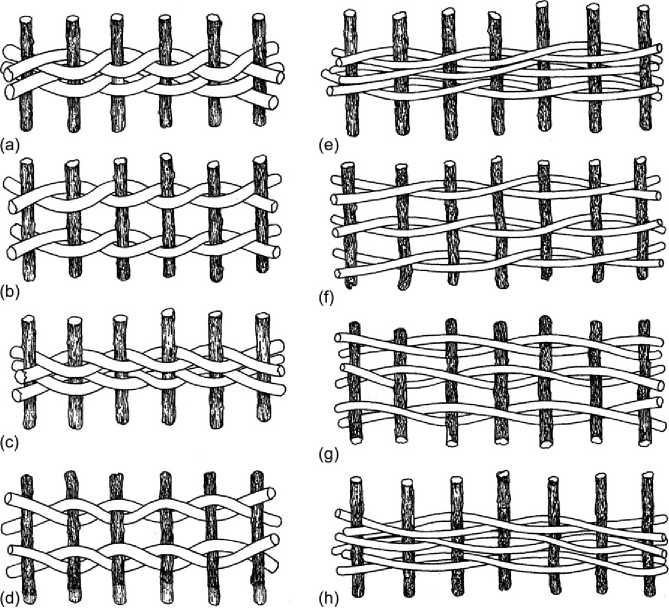
Figure 1 Schematic showing some common types of twining. As labeled, (a) is Close Simple Twining, S-twist Wefts; (b) is Open Simple Twining, S-twist Wefts; (c) is Close Simple Twining, Z-twist Wefts; (d) is Open Simple Twining, Z-twist Wefts; (e) is Close Diagonal Twining, S-twist Wefts; (f) is Open Diagonal Twining, S-twist Wefts; (g) is Close Diagonal Twining, Z-twist Wefts; (h) is Open Diagonal Twining, Z-twist Wefts.
For purposes of this discussion, any basket (or textile) is assumed to have several distinct parts, the most significant of which is the ‘wall’ or main body of the specimen. In most forms of basketry or textile, the main body is readily distinguishable from the edge (selvage or rim) as well as in the case of containers, the center.
The wall or main body of a basket, mat, or bag can be constructed by only three basic manipulative procedures or weaves which correspond directly to the three major subclasses of basketry: twining, coiling, and plaiting. The procedures are so distinctive that even when all three are employed in the same specimen (a very rare occurrence), it is easy to detect where one ends and the other begins.
After sorting into subclasses, each specimen of basketry is assigned to a technological type. The protocols for assignment to types are detailed in Adovasio (1977) and briefly summarized below. Twined baskets are allocated to types based upon the spacing of the weft rows (open or close) and in the number and sequence of warps engaged at each weft crossing (simple or diagonal). Coiled specimens are allocated to types based on the kind of basket wall or foundation technique and the type of stitch employed. Plaited specimens are assigned to types based on the number of plaiting elements and the interval of element engagement. Any specimens which cannot be assigned to technological types are placed in arbitrary categories based on their predominant technological, structural, and formal attributes (Figure 3).
In addition to typing, all examples of each subclass of basketry are examined for additional attributes. Where feasible, twined specimens are analyzed for selvage (edge treatment), method of starting, method of insertion of new warp and weft elements, method of preparation of warps and wefts, form, wear patterns, adherent residues, function, decorative techniques, and the type and mechanics of mending. Coiled specimens are also assessed for type of rim finish, method of starting, work direction, decorative patterns and mechanics, type and mechanics of mending, form, wear patterns, adherent residues, function, method and preparation of foundation and sewing elements, and type of splice. Plaiting specimens are examined for selvage treatment; method of starting; number, orientation, composition, and preparation of plaiting elements; wear patterns; adherent residues; form; decorative mechanics; mechanics of mending; and function.
Because there is considerably greater potential variety to a textile assemblage, the number of possible
False braid at termination of rim
Bundle Rods Stitch
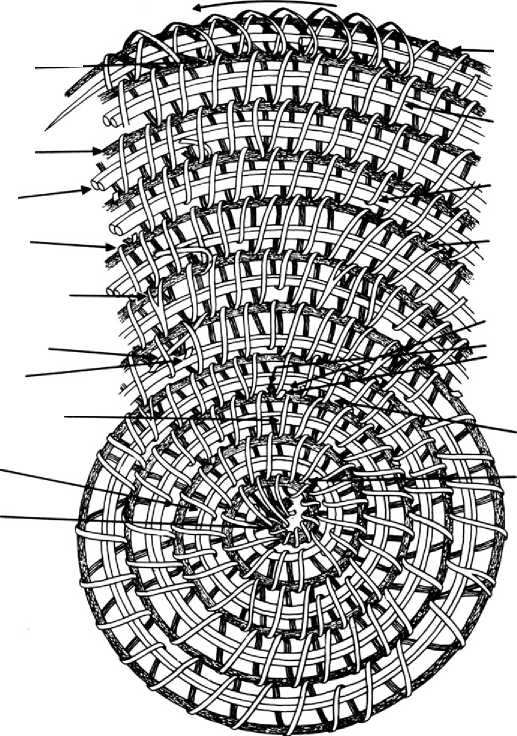
Work surface: sewing awl is thrust through bundle from this side Stitch slant = l
Cross section of coil Bundle Rods Stitch
Figure 2 Schematic example of close coiled basketry.
Types which may occur can exceed the diversity of types in a basketry assemblage. The protocols for analyzing and classifying textiles are detailed in Emery (1966). Essentially, the process of classification involves initial division of the assemblage into broad groups of specimens based on the number of elements employed in the weaving process. The basic categories are single-element and multiple-element fabrics within which there are a great number of specific structural types and even subtypes. Space precludes any further discussion of assignment to type but, as with basketry, after the typing process is complete, all textile specimens are also analyzed, where feasible, for a wide variety of other attributes including selvage, the use of wrapping elements, accessory structures (e. g., added stitches), elements of decoration, wear patterns, adherent residues, form, and possible function.
Cordage and Netting
Cordage is a class of elongate fiber artifacts which are generally subsumed under the English terms ‘string’ and ‘rope’. Netting is a cordage-based fiber construction which Emery defines as a fabric ‘‘built up by the repeated inter-working of a single continuous element with itself’’. Where preservation permits, cordage and cordage-based constructions such as netting may be the most common categories of fiber artifacts recovered.
The analysis of cordage is fairly straightforward and the most commonly employed protocols follow Hurley. Cordage and cordage-based fiber artifacts have a relatively limited number of structural attributes when compared with basketry, textiles, or sandals. For cordage, assignment to types is established on the basis of only three structural attributes:
1. Number and composition of plies (1, 2, or more; simple or compound).
2. Direction of initial ‘spin’ (S or Z).
3. Direction of final twist (S or Z).
The term ‘ply’ as used here means a strand or bunch of fibrous material that is almost always twisted.
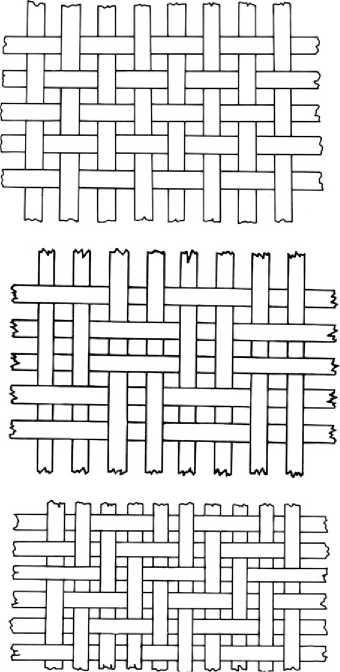
Figure 3 Schematic showing some common types of plaiting. From top to bottom, they are Simple Plaiting 1/1 Interval, Simple Plaiting 1/1 Interval with Paired Elements, and 2/2 Twill Plaiting.
These strands can be used alone to form single-ply cordage or in groups to form multiple-ply cordage. Multiple-ply cordage is produced by twisting two or more ‘single’ plies together.
An individual ply is simple if it consists of a single strand or bunch of material with the same twist, or it may be compound. Compound plies are constructed with multiple strands or bunches of material individually twisted and then twisted with each other in the opposite direction (Figure 4). Compound plies are therefore separate pieces of cordage which when twisted with other plies form a technically distinct cordage type.
In addition to assignment to types, cordage is also analyzed for splices (the introduction of new plies), angle of initial and final twist, and, where germane, ancillary cordage manipulations like rat-tailing, crepe twisting, or ply-wrapping. Cordage may also be evaluated for wear, adherent residue, and possible function. Any knots encountered are analyzed and described following a standard knot reference.
Netting in various forms is one of the most commonly encountered cordage-based by-products. Unlike basketry, textiles, or cordage, there is no standard or

Figure 4 Schematic showing cordage construction.
Generally accepted set of analytical protocols for this subclass of fiber artifacts. Following Emery, there are basically only two ways to produce the structure of a single element fabric in any form. These categories are usually called knotless (Figure 5) and knotted netting (Figure 6).
Knotless netting may, in turn, be divided into a series of technological types based on the manipulation of the cordage employed in the construction. Such netting structures are either linked or looped and within these categories several variations exist. The analysis of knotless netting therefore involves two separate trajectories: the identification of the cordage type or types used in the construction and then the determination of the variety of knotless netting represented in the piece.
In knotted netting, the fabric of the fiber artifact is built up in rows secured by knots. The assignation of knotted netting to types is usually based on the type of knot employed in the construction and the process of building up the individual rows of fabric. Like knotless netting, the cordage employed in the construction of knotted nets must also be analyzed.
In addition to the foregoing, all netting constructions are scrutinized for kind and degree of preparation of raw materials employed in the construction, splices, mends, wear patterns, adherent residues, and where possible, form and function.
Sandals, Cradles, and Other Fiber Artifacts
Sandals are essentially baskets (or textiles) worn on the feet (Figure 7). Cradles are basically baskets
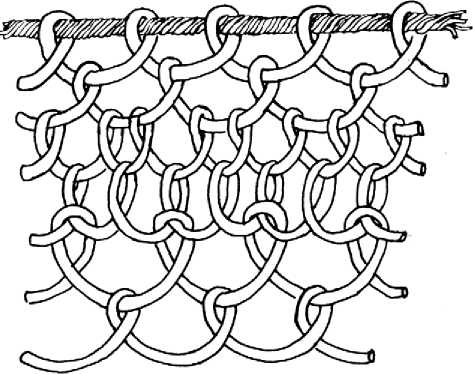
Figure 5 Knotless netting. From Tanner 1976: 57 figure 3.8g.
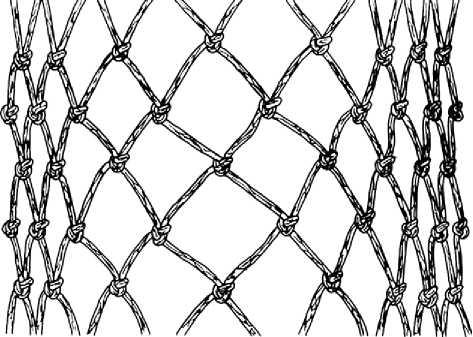
Figure 6 Knotted netting.
Designed to contain and/or transport infants Figure 8. The analytical protocols for these fiber artifacts essentially follow those employed for basketry or textiles and, as most sandals or cradles are usually twined or plaited, follow the protocols associated with these subclasses of fiber artifacts.
Of course, with both of these formal types of artifacts, certain analytical procedures are unique to these items. For example, sandals require - in addition to identification of the techniques involved in the basic construction of the sole - determination of the methods used to produce such sandal-specific features as toe flaps, heel pockets, ties, sole pads, socks, treads, and insulation. There are also similar cradle-specific attributes which must also be analyzed.
After the analysis of the basketry, textiles, cordage, cordage by-products, sandals, and other more or less standardized fiber artifacts from any given assemblage, there will always be finished and partially finished artifacts ‘left over’. These items, which do not comfortably fit standard classificatory or taxonomic schema, are usually called miscellaneous fiber constructions and are allocated to categories based on predominant formal and/or structural attributes. Such categories may include exotic or aberrant types of basketry or textiles whose construction does not correspond to known macro-patterns; as well as such diverse items as fiber-wrapped sticks, fiber ‘rings’, or ‘doodles’.
A collection also usually contains construction materials or individual plant fiber or wood components employed in the manufacture or decoration of one or another kind of fiber artifact. Space again precludes any delineation of the protocols to be
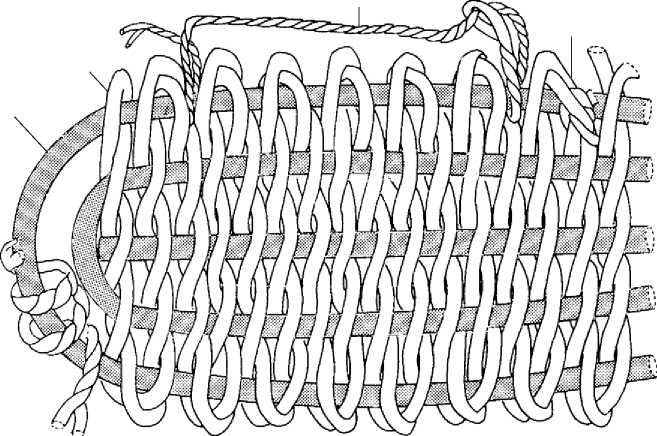
Figure 7 Schematic example of a twined sandal.
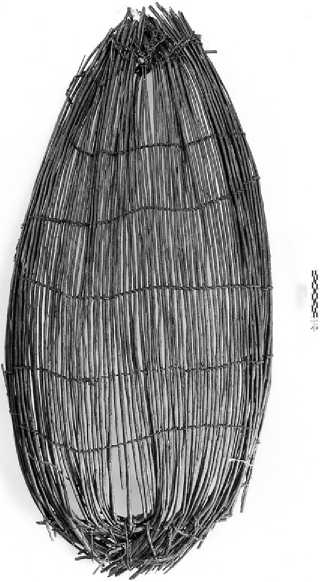
Figure 8 Example of an open twined cradle.
Employed for such items but details are available in Adovasio (1977).
Additionally, sandals, cradles, and other less-standardized fiber artifacts are also examined for wear patterns, adherent residues, mends, decorative mechanics, and, of course, raw materials and their method(s) of preparation.
Interpretation of the data. After analysis, representatives of each technological type and miscellaneous category should be photographed. If feasible (and this is my practice), virtually all specimens should be photographed even though this may be timeconsuming and costly.
Minimally, the analyst should photograph both sides of at least one representative of each type or miscellaneous category and each complete or nearly complete specimen. Where warranted, close-ups of construction details such as centers, rims, splices, and other attributes of basketry should be taken, as well as multiple views of three-dimensional items. The latter should include plan views and profiles. Photography of fiber artifacts, like photography of any other class of artifact, requires a considerable degree of skill and patience. As in the analysis process, the photographer must frequently experiment with lighting angles and intensities to bring out the significant features.
All specimens should be photographed in their ‘normal’ orientation. For instance, with basketry specimens, twining fragments should be positioned with the warps vertical and the wefts horizontal; coiling fragments should have the foundation horizontal and the stitches vertical. Fragments of simple plaiting should be oriented with one set of elements parallel to the long axis of the viewer, while twill plaited fragments should be arranged so that the crossing points of opposing sets of elements form a series of versus parallel to the long axis of the viewer. Complete or nearly complete specimens of any subclass of fiber artifact should be oriented as their specific characteristics dictate. An easily read metric scale should be included in all photographs.




 World History
World History









